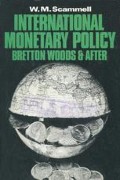Abstract
The process of adjusting a country’s balance-of-payments deficit either by purposive policies or by an internationally agreed system is the most important problem in international monetary economics. A perfect policy system were it possible and were it implemented with complete understanding would end a century-long search, reduce to vanishing point the discussion of international monetary policy, and remove from international politics a whole dimension which has existed since the First World War. Realisation by economists of this central role for balance-of-payments adjustment has produced a considerable literature over the past twenty years, but in the world of affairs we are still in a state of hesitancy, of tentative moves to improve situations rather than soundly based policies carried through to completion. In this chapter we shall examine some of the practical issues raised by the theory of adjustment as we now find it and, in particular, by those aspects of it which we have sketched in the previous chapter. To do this we shall divide policies into two groups: those which are expenditure-reducing, which seek to operate upon the foreign balance by curtailing the level of domestic absorption; and those which switch expenditures through the medium of changing the exchange rate. In particular, for this latter group, we are concerned with the question: what are the merits and demerits of the several possible systems of exchange-rate operations which may be adopted?
Preview
Unable to display preview. Download preview PDF.
Notes
Ragnar Nurkse, ‘International Monetary Equilibrium’, Essays in International Finance, no. 4 (Princeton University Press, 1945). The above discussion follows that of Nurkse which was itself published soon after Bretton Woods and was intended to clarify the inconclusive literature which had burgeoned at that time concerning the Fund’s use of the term ‘fundamental disequilibrium’.
For example, James Meade, ‘The Case for Variable Exchange Rates’, Three Banks Review (September 1955),
Milton Friedman, ‘The Case for Flexible Exchange Rates’ Essays in Positive Economics (Chicago: University of Chicago Press, 1953) pp. 157–203,
and W. M. Scammell ‘What Sort of Exchange Rates’, Westminster Bank Review (May 1954).
The most notable book, at a high level of discussion, was Egon Sohmen’s Flexible Exchange Rates, Theory and Controversy (Chicago: University of Chicago Press, 1961).
C. P. Kindleberger, ‘Flexible Exchange Rates’, Monetary Management, prepared for the Commission on Money and Credit (1963).
James Meade, Theory of International Economic Policy, vol. I, The Balance of Payments(Oxford: Oxford University Press, 1951) p. 220.
Milton Friedman, ‘The Case for Flexible Exchange Rates’, Essays in Positive Economics (Chicago: University of Chicago Press, 1953) pp. 157–203.
We must be careful here to avoid over-simplification. Y and E are interdependent, since expenditure varies with the level of income and, in turn, income varies with expenditure. Any change in income or expenditure will therefore impel multiplier changes in both, and the final relation of Y to E and therefore B, will be altered. It can, however, be shown that so long as the marginal propensity to absorb is less than unity the multiplier effects will not be strong enough to cancel the initial change. An initial impact increase in output or decrease in expenditure will always improve B. For a demonstrative proof of this point see H. G. Johnson, ‘Towards a General Theory of the Balance of Payments’, in Readings in International Economics (Homewood, Ill.: Irwin, 1968), p. 382.
Copyright information
© 1975 W. M. Scammell
About this chapter
Cite this chapter
Scammell, W.M. (1975). The Methods of Adjustment: Policy. In: International Monetary Policy. Palgrave, London. https://doi.org/10.1007/978-1-349-86171-2_4
Download citation
DOI: https://doi.org/10.1007/978-1-349-86171-2_4
Publisher Name: Palgrave, London
Print ISBN: 978-0-333-18295-6
Online ISBN: 978-1-349-86171-2
eBook Packages: Palgrave Economics & Finance CollectionEconomics and Finance (R0)

